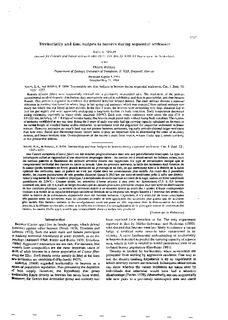| dc.description.abstract | Beavers (Castor fiber) were sequentially released into a previously unoccupied area. The settlement of the animals approximated an ideal despotic distribution: they successively settled in rich habitat and then in poor habitat, and then became floaters. This pattern is regarded as evidence that territorial behavior limited density. The early arrivals showed a seasonal difference in territory size (small in winter, large in late spring and summer), which was expected from optimal territory size theory but which was not found in later arrivals. In the first 2 years, the beavers were swimming very large distances (up to 20.0 km per night), and were apparently undergoing a long-term decline in body condition. Body temperature decreased during swimming, especially in winter (daily amplitude 2.04 °C). Each year, winter territories were about the size (7.9 ± 0.9 (SE) km, including 3.0 ± 0.4 km of wooded banks) that beavers could patrol daily without losing body condition. The number of territories established at any one time during the 5 years of study was only half the carrying capacity calculated on the basis of the current length of wooded banks within territories, in accordance with the prediction for sequential settlement in linear habitats. However, extensive no-man's-land was not present between territories, but early arrivals claimed larger territories than later ones. Social and thermoregulatory factors seem to play an important role in determining the costs of territory defense, and hence territory size. Overexploitation of the beaver's main food source, willow (Salix spp.), seems unlikely in this productive habitat. | |
